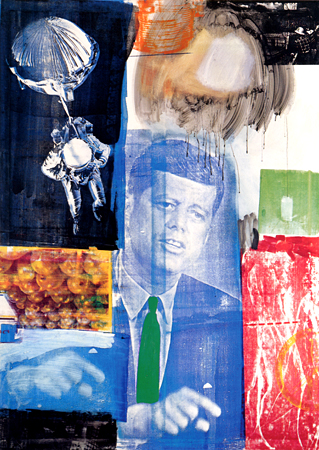The coming week sees the fortieth anniversary of the presidential inauguration of John F. Kennedy. So today’s picture is Robert Rauschenberg’s silkscreen painting Retroactive I, dominated as it is by an image based on a photograph of Kennedy in full flow at one of his televised press conferences.
When Rauschenberg started Retroactive I the president was still alive and well. Then, on November 22 1963, news came through of his assassination. Having almost decided to abandon his painting altogether the artist eventually reworked it into a meditation on Kennedy’s death and on the central place he had assumed, through his martyrdom, in modern American mythology.
Rauschenberg’s original idea had not been to create a memorial, but something very different. He was one of the first post-war American artists to take inspiration from popular culture. He wanted to bring the life of the street into the studio and to dismantle the perceived barriers separating the world of fine art from that of mass media such as advertising, news photography and television. His ideal was an art that would reflect the discontinuous, image-saturated reality of urban existence in 1960s America. Explaining the genesis of his collage-derived silkscreen paintings, he said: “I was bombarded with TV sets and magazines, by the refuse, by the excess of the world… I thought that if I could paint or make an honest work, it should contain all of these elements, which were and are a reality. Collage is a way of getting an additional piece of information that is impersonal. I’ve always tried to work impersonally.”
Such ideas left their trace on Retroactive I. Appropriating imagery from mass media sources – such as the picture of Kennedy himself or the astronaut with parachute – was one of Rauschenberg’s ways of striving for the impersonality...

ITP 39: Retroactive I, by Robert Rauschenberg
14-01-2001

